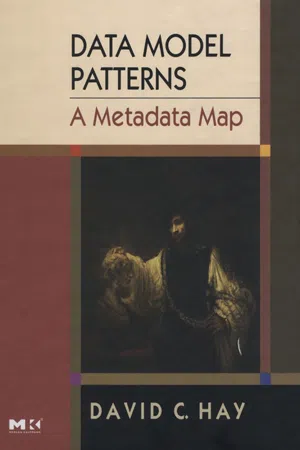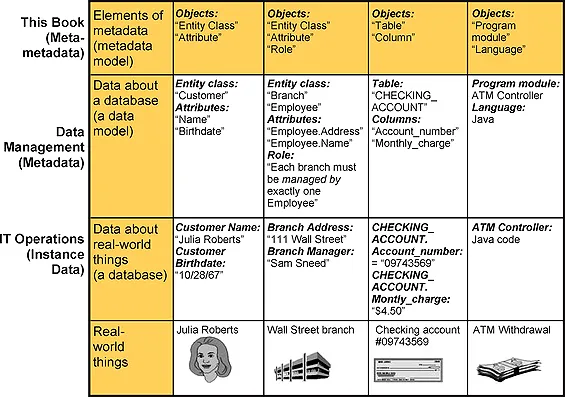
- 432 pages
- English
- ePUB (mobile friendly)
- Available on iOS & Android
eBook - ePub
Data Model Patterns: A Metadata Map
About this book
Data Model Patterns: A Metadata Map not only presents a conceptual model of a metadata repository but also demonstrates a true enterprise data model of the information technology industry itself. It provides a step-by-step description of the model and is organized so that different readers can benefit from different parts.
It offers a view of the world being addressed by all the techniques, methods, and tools of the information processing industry (for example, object-oriented design, CASE, business process re-engineering, etc.) and presents several concepts that need to be addressed by such tools.
This book is pertinent, with companies and government agencies realizing that the data they use represent a significant corporate resource recognize the need to integrate data that has traditionally only been available from disparate sources. An important component of this integration is management of the "metadata" that describe, catalogue, and provide access to the various forms of underlying business data. The "metadata repository" is essential to keep track of the various physical components of these systems and their semantics.
The book is ideal for data management professionals, data modeling and design professionals, and data warehouse and database repository designers.
- A comprehensive work based on the Zachman Framework for information architecture—encompassing the Business Owner's, Architect's, and Designer's views, for all columns (data, activities, locations, people, timing, and motivation)
- Provides a step-by-step description of model and is organized so that different readers can benefit from different parts
- Provides a view of the world being addressed by all the techniques, methods and tools of the information processing industry (for example, object-oriented design, CASE, business process re-engineering, etc.)
- Presents many concepts that are not currently being addressed by such tools — and should be
Frequently asked questions
Yes, you can cancel anytime from the Subscription tab in your account settings on the Perlego website. Your subscription will stay active until the end of your current billing period. Learn how to cancel your subscription.
No, books cannot be downloaded as external files, such as PDFs, for use outside of Perlego. However, you can download books within the Perlego app for offline reading on mobile or tablet. Learn more here.
Perlego offers two plans: Essential and Complete
- Essential is ideal for learners and professionals who enjoy exploring a wide range of subjects. Access the Essential Library with 800,000+ trusted titles and best-sellers across business, personal growth, and the humanities. Includes unlimited reading time and Standard Read Aloud voice.
- Complete: Perfect for advanced learners and researchers needing full, unrestricted access. Unlock 1.4M+ books across hundreds of subjects, including academic and specialized titles. The Complete Plan also includes advanced features like Premium Read Aloud and Research Assistant.
We are an online textbook subscription service, where you can get access to an entire online library for less than the price of a single book per month. With over 1 million books across 1000+ topics, we’ve got you covered! Learn more here.
Look out for the read-aloud symbol on your next book to see if you can listen to it. The read-aloud tool reads text aloud for you, highlighting the text as it is being read. You can pause it, speed it up and slow it down. Learn more here.
Yes! You can use the Perlego app on both iOS or Android devices to read anytime, anywhere — even offline. Perfect for commutes or when you’re on the go.
Please note we cannot support devices running on iOS 13 and Android 7 or earlier. Learn more about using the app.
Please note we cannot support devices running on iOS 13 and Android 7 or earlier. Learn more about using the app.
Yes, you can access Data Model Patterns: A Metadata Map by David C. Hay in PDF and/or ePUB format, as well as other popular books in Computer Science & Data Modelling & Design. We have over one million books available in our catalogue for you to explore.
Information
1
ABOUT METADATA MODELS
There once was a fellow named Corey
Whose career was not covered in glory
He had a bad day
When he just couldn’t say
Me-ta-da-ta Re-pos-i-TOR-y.
WHAT ARE METADATA?*
During the 1990s, the concept of data warehouse** swept the information technology industry. After many years of trying, it appears finally to be possible for a company to store all of its data in one place for purposes of reporting and analysis. The technology for doing this is still new, and the first attempts have had mixed results, but the effort has been quite serious.
One of the problems that arose from this effort was the realization that if a senior executive is going to ask a giant database a question it is necessary to know just what is in the database and what types of questions to ask. In addition to the data themselves, therefore, it is necessary to keep data about the data. The term coined for “data about data” during the 1990s was metadata.
Since then, numerous books and magazine articles have been published on this subject, but most have focused on why metadata are important and on technologies and techniques for managing them. What these publications have left out is a clear description of exactly what the stuff is. After a decade, there is still no simple, clear description of metadata in a form that is both comprehensive enough to cover our industry and comprehensible enough that it can be used by people. This book is an attempt to produce such a description.
As with all buzzwords, once invented the term metadata has taken on a life of its own. It is variously described as:
• Any data about the organization’s data resource [Brackett 2000, p. 149].
• All physical data and knowledge from inside and outside an organization, including information about the physical data, technical and business processes, rules and constraints of the data, and structures of the data used by a corporation [Marco 2000, p. 5].
• The detailed description of instance data. The format and characteristics of populated instance data: instances and values, dependent on the role of the metadata recipient [Tannenbaum 2002, p. 93].
Several significant points come out of these definitions. First, as Mr. Marco pointed out there is a difference between business metadata and technical metadata. The business user of metadata is interested in definitions and structures of the language as terms for the types of information to be retrieved. The technician is concerned with the physical technologies used to store and manage data. Both of these points of view are important, and both must be addressed.
Second, the subject is concerned with more than just data. It is, as Mr. Brackett said, “any data about an organization’s data resource.” Once you have started looking at the structure of an organization’s data, you have to also account for its activities, people and organizations, locations, timing and events, and motivation.
Third, as Ms. Tannenbaum pointed out, the “meta” aspect of the question is a matter of point of view. There is metadata relative to the data collected by the business. There is also meta-metadata, which is used to understand and manage the metadata.*
This last point is illustrated in Figure 1-1. Here, the bottom row shows examples of things in the world that are often described in information systems. “Julia Roberts” is a real human being. The “Wall Street branch” of a bank is a physical place were business is performed. Checking account “09743569” is a particular account held in that bank by a particular customer (Julia Roberts, for example). The customer of that account may then perform an actual “ATM Withdrawal” at a specific time.

Fig. 1-1 Data and metadata.
The next row up shows, in the first three columns, the data that might describe those three things: (1) A Customer has the name “Julia Roberts” and the “Birthdate” of “10/28/67”. (2) A Branch has the address “111 Wall Street” and a manager, “Sam Sneed”. (3) The checking account has an account number “09743569” and a monthly charge, “$4.50”. In the fourth column, the first row from the bottom shows that a particular program, called here “Java code”, is responsible for a “Withdrawal Transaction”. These are the things that would concern a person managing data for a banking business. Note that each of the terms was described as to what it was: customer name, branch manager, account number, and so forth.
The third row from the bottom collects those descriptors and labels them in turn. This is to create what we in the data administration world call the metadata. There are two components to these labels. First are the names of the things of significance being described by the business data, such as the entity classes “Customer” and “Branch”. Second, each of these is in turn described by attributes, such as “Name”, “Address”, and “Birthdate”. We also discover, in the case of the bank branch, that there is really an additional entity class, “Manager”, and that it is related to “Branch”. (“Each Branch must be managed by exactly one Employee.”)
In the checking account column, we see that a checking account is actually the subject of a table in a database. The table is called “CHECKING_ACCOUNT” and has columns “Account_number” and “Monthly_charge”. The ATM program described in the second row simply as “Java code” is actually a program module with the name “ATM Controller” written in the language “Java”. As we can see, the metadata row itself encompasses several different types of objects (“Entity class”, “Attribute”, “Table”, “Column”, “Program module”, and “Language”). The assignment of this book, represented by the top row, is to show how these objects relate to one another.
Metadata don’t just describe data. They describe how the organization understands not only its data, but also its activities, people and organizations, geography, timing, and motivation. Yes, metadata describe the entity classes and attributes of an entity-relationship model, and the tables and columns by which these are implemented in a computer system. They also provide, however, structure for describing the activities of the organization and the computerized processes that implement these activities. They describe who has access to data, and why. They describe the types of events and responses that are the nature of an organization’s activities. They describe where the data and processes are, and they describe the motivation and business rules that drive the entire thing. So, from all of this comes the following definition of metadata.
Metadata are the data that describe the structure and workings of an organization’s use of information, and which describe the systems it uses to manage that information.
One anomaly has revealed itself in the line between business data and metadata. The information about what constitutes a legal value for a product category or an account type in the business model is often captured in separate reference tables. To reflect these validation structures, a typical data model often has many “type” entity classes (ACCOUNT TYPE, STATUS, DAY OF THE WEEK, and so on) describing legal values for attribu...
Table of contents
- Cover image
- Title page
- Table of Contents
- The Morgan Kaufmann Series in Data Management Systems: Series Editor: Jim Gray, Microsoft Research
- Copyright
- Dedication
- Dedication
- PREFACE
- FOREWORD
- Chapter 1: ABOUT METADATA MODELS
- Chapter 2: DATA
- Chapter 3: ACTIVITIES, FUNCTIONS, AND PROCESSES
- Chapter 4: LOCATIONS
- Chapter 5: PEOPLE AND ORGANIZATIONS
- Chapter 6: EVENTS AND TIMING
- Chapter 7: MOTIVATION
- GLOSSARY
- REFERENCES AND FURTHER READING
- ABOUT THE AUTHOR
- INDEX